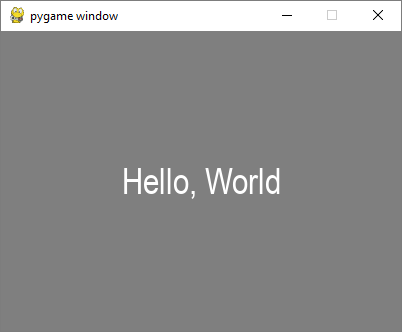
- Pygame 教程
- Pygame - 首頁
- Pygame - 概述
- Pygame - Hello World
- Pygame - 顯示模式
- Pygame - Locals 模組
- Pygame - 顏色物件
- Pygame - 事件物件
- Pygame - 鍵盤事件
- Pygame - 滑鼠事件
- Pygame - 繪製形狀
- Pygame - 載入影像
- Pygame - 在視窗中顯示文字
- Pygame - 移動影像
- Pygame - 使用數字小鍵盤移動
- Pygame - 使用滑鼠移動
- Pygame - 移動矩形物件
- Pygame - 使用文字作為按鈕
- Pygame - 影像變換
- Pygame - 音效物件
- Pygame - 混音器通道
- Pygame - 播放音樂
- Pygame - 播放影片
- Pygame - 使用攝像頭模組
- Pygame - 載入游標
- Pygame - 訪問 CDROM
- Pygame - 精靈模組
- Pygame - PyOpenGL
- Pygame - 錯誤和異常
- Pygame 有用資源
- Pygame - 快速指南
- Pygame - 有用資源
- Pygame - 討論
Pygame - 在視窗中顯示文字
要在 Pygame 視窗上顯示文字,我們首先需要獲取一個字型物件,這可以透過 pygame.font 模組中定義的 SysFont() 函式來實現。
Fnt= SysFont(name, size, bold=False, italic=False)
可以使用 get_fonts() 函式獲取當前機器上安裝的字型列表。
fonts = pygame.font.get_fonts() for f in fonts: print(f)
讓我們定義一個表示 36 號 Arial 字型的字型物件。
font = pygame.font.SysFont("Arial", 36)
接下來,我們使用 Font 物件的 render() 方法,使用新建立的字型渲染 "Hello World" 文字,獲取一個新的 Surface 物件。
txtsurf = font.render("Hello, World", True, white)
第一個引數是一個單行字串,第二個引數表示抗鋸齒。如果設定為 False,則渲染的影像是 8 點陣圖像,如果為 True,則為 24 點陣圖像。還可以使用可選的背景顏色引數。
現在我們需要將文字 Surface 繪製到螢幕視窗的中心。
screen.blit(txtsurf,(200 - txtsurf.get_width() // 2, 150 - txtsurf.get_height() // 2))
示例
以下是完整的程式碼:
import pygame
pygame.init()
screen = pygame.display.set_mode((400, 300))
done = False
white=(255,255,255)
red = (255,0,0)
green = (0,255,0)
blue = (0,0,255)
bg = (127,127,127)
while not done:
for event in pygame.event.get():
screen.fill(bg)
if event.type == pygame.QUIT:
done = True
font = pygame.font.SysFont("Arial", 36)
txtsurf = font.render("Hello, World", True, white)
screen.blit(txtsurf,(200 - txtsurf.get_width() // 2, 150 - txtsurf.get_height() // 2))
pygame.display.update()
輸出

除了 SysFont() 方法外,還可以從字型檔案(具有 .ttf 副檔名)或指向 ttf 檔案的 Python 檔案物件獲取 Font 物件。也可以使用 .ttc 檔案構造字型物件。font 類定義了以下方法:
| bold() | 獲取或設定字型是否應以粗體渲染。 |
| italic() | 獲取或設定字型是否應以斜體渲染。 |
| underline() | 獲取或設定字型是否應帶下劃線渲染。 |
| render() | 在新的 Surface 上繪製文字 |
| size() | 計算渲染文字所需的尺寸 |
| set_underline() | 控制文字是否帶下劃線渲染 |
| get_underline() | 檢查文字是否將帶下劃線渲染 |
| set_bold() | 啟用粗體文字的偽渲染 |
| get_bold() | 檢查文字是否將以粗體渲染 |
| set_italic() | 啟用斜體文字的偽渲染 |
| metrics() | 獲取每個字元的度量 |
| get_italic() | 檢查文字是否將以斜體渲染 |
| get_linesize() | 獲取字型的行距 |
| get_height() | 獲取字型的 高度 |
| get_ascent() | 獲取字型的 上升高度 |
| get_descent() | 獲取字型的 下降高度 |
下面是使用 ttf 和 ttc 檔案渲染文字的示例。
font1 = pygame.font.SysFont('chalkduster.ttf', 72)
img1 = font1.render('Hello World', True, BLUE)
font2 = pygame.font.SysFont('didot.ttc', 72)
img2 = font2.render('Hello Pygame', True, GREEN)
screen.blit(img1, (20, 50))
screen.blit(img2, (20, 120))
pygame.display.update()
在上面的示例中,預定義的字串已被渲染為 Surface 物件。但是,可以讀取 KEYDOWN 事件的鍵值以互動式地輸入字串並顯示它。
首先,我們渲染一個空字串。接下來,我們定義邊界矩形,然後定義一個游標矩形,該矩形放置在與文字邊界矩形重疊的位置。KEYDOWN 事件中識別的每個按鍵都附加到原始空字串中並重復渲染。
示例
以下程式碼最初顯示一個空白視窗。按下每個字母都將彼此並排顯示。
import pygame
pygame.init()
screen = pygame.display.set_mode((400, 300))
done = False
white=(255,255,255)
red = (255,0,0)
green = (0,255,0)
blue = (0,0,255)
bg = (127,127,127)
text=""
while not done:
for event in pygame.event.get():
screen.fill(bg)
if event.type == pygame.QUIT:
done = True
if event.type == pygame.KEYDOWN:
text=text+event.unicode
font = pygame.font.SysFont("Arial", 36)
img = font.render(text, True, white)
rect = img.get_rect()
cursor = pygame.Rect(rect.topright, (3, rect.height))
img = font.render(text, True, white)
rect.size=img.get_size()
cursor.topleft = rect.topright
screen.blit(img,(200 - img.get_width() // 2, 150 - img.get_height() // 2))
pygame.display.update()
輸出
執行以上程式碼並輸入一些文字。示例輸出如下:

廣告